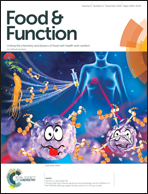An additional data fusion strategy for the discrimination of porcini mushrooms from different species and origins in combination with four mathematical algorithms†
Abstract
Porcini are a source of popular food products with many beneficial functions and the internal quality of these mushrooms is largely determined by many factors. An additional data fusion strategy based on low-level data fusion for two portions (cap and stipe) and mid-level data fusion for two spectroscopic techniques (UV and FTIR) was developed to discriminate porcini mushrooms from different species and origins. Based on a finally obtained data array, four mathematical algorithms including PLS-DA, k-NN, SVM and RF were comparatively applied to build classification models. Each calibrated model was developed after selecting the best debug parameters and then a test set was used to validate the established model. The results showed that the SVM algorithm based on a GA procedure searching for parameters had the best performance for discriminating different porcini samples with the highest cross-validation, specificity, sensitivity and accuracy of 100.00%. Our study proved the feasibility of two spectroscopic techniques for the discrimination of porcini mushrooms originated from different species and origins. This proposed method can be used as an alternative strategy for the quality detection of porcini mushrooms.



 Please wait while we load your content...
Please wait while we load your content...